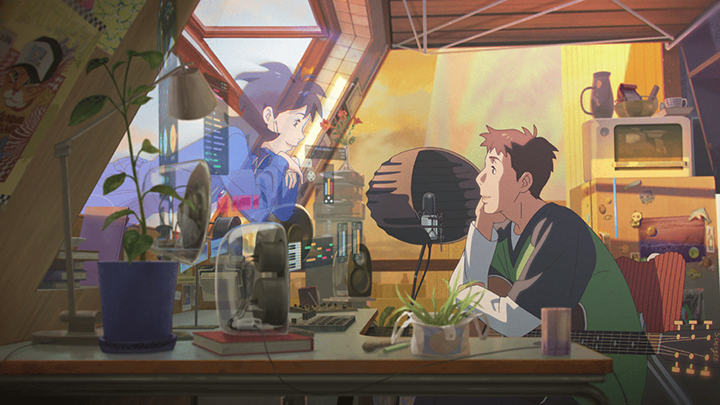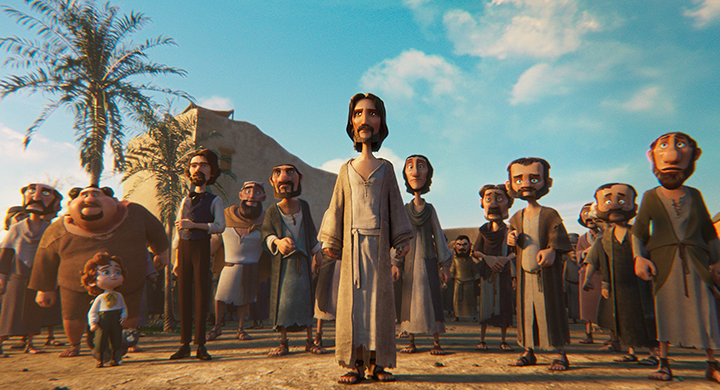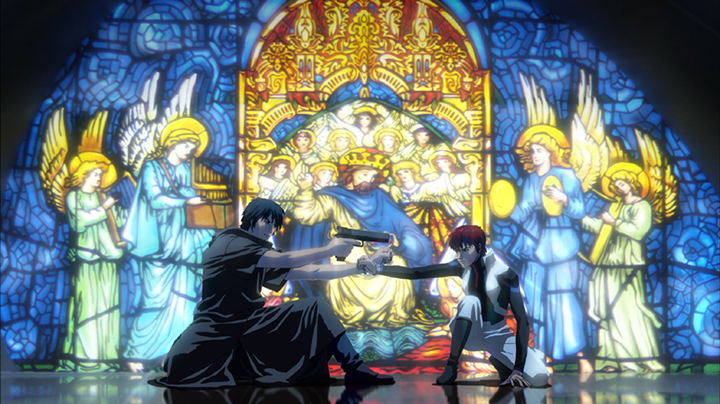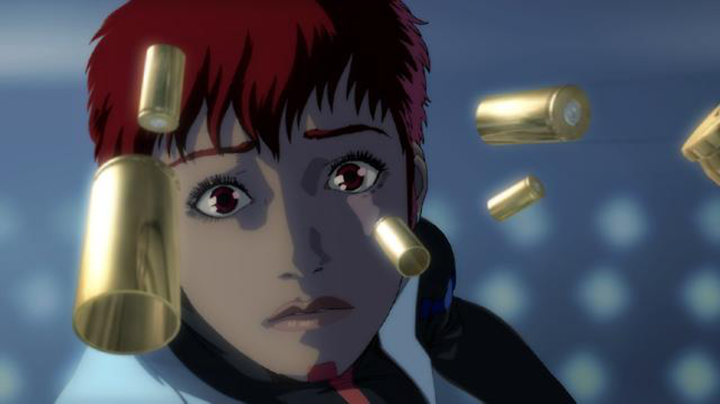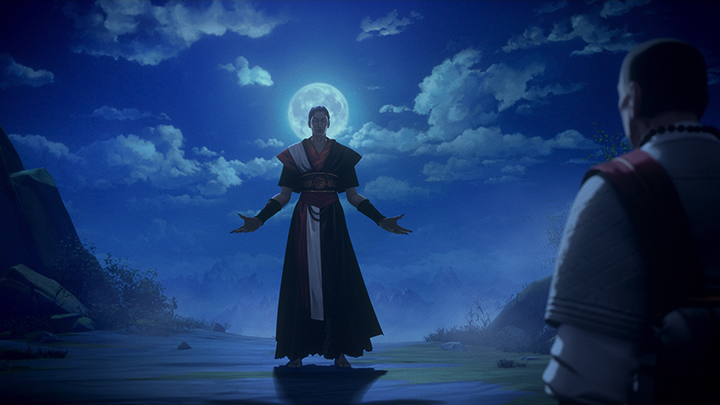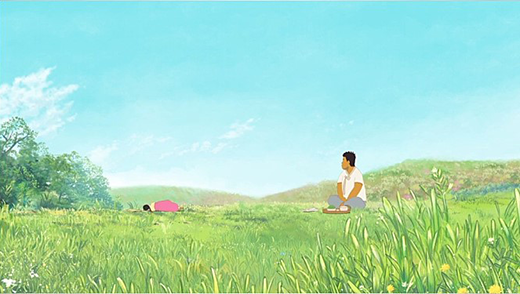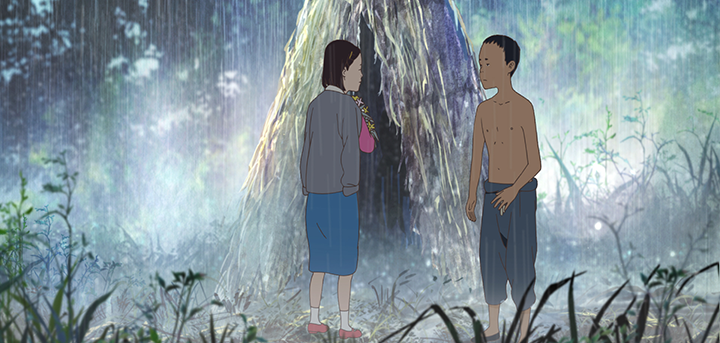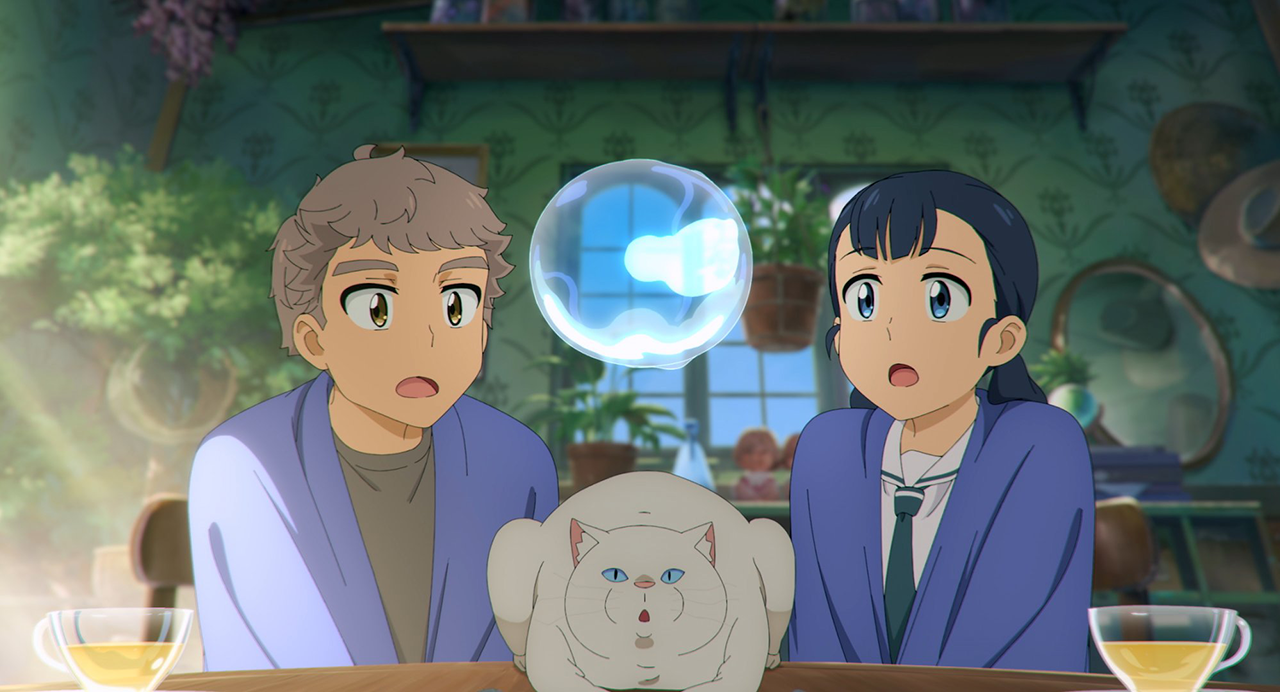우주의 기운이 정말 한국으로 모이고 있는 걸까. 지난 6월 20일 넷플릭스에서 공개한 애니메이션 <케이팝 데몬 헌터스>(이하 <케데헌>)가 세계적인 인기를 모으고 있는 상황이 다소 생경하다. K-팝이 전 세계적인 인기를 끌고 있다는 사실을 알고 있다 해도 <케이팝 데몬 헌터스>라니. 마동석도 아니고 K-팝으로 악마를 때려잡는다는 것인가? 전 세계적으로 심상치 않은 반응이 일어나면서 역으로 한국에서도 뒤늦게 반향을 일으키기 시작했다. “<케데헌> 봤어?”라는 질문이 곳곳에서 넘어왔다. 그리고 <케데헌>이 한국이 아닌 미국에서 제작된 작품이라는 사실도 화제성을 높이는 데 한몫했다. 단순히 K-팝 넘버를 부르는 것을 넘어 머리부터 발끝까지 ‘K’로 두른 미제 애니메이션이 전 세계를 강타하고 있다는 사실 자체가 한국인 입장에서는 흥미로운 이벤트일 수밖에 없다.
그러니까 어쨌든 <케데헌>은 할리우드 애니메이션이라는 것이다. 일찍이 K-팝에 빠진 한국계 캐나다인 교포 감독의 팬픽(Fanfic: Fan Fiction의 준말로, 특정 작품의 팬이 만든 2차 창작물을 말함)이다. 만약 이런 작품을 한국에서 기획했다면 되레 “이거 국뽕이 너무 심한 것 아니요”라는 식의 자조적인 반응에 시달렸을지도 모른다. 하지만 남의 상찬은 달다. 심지어 전 세계 대중문화 산업과 시장에서 최상위로 분류되는 미국에서 이렇게 완성도 높은 K-팝 애니메이션을 만들다니 한국인으로서는 되레 K-팝을 비롯한 한국 문화를 재발견하게 될 계기를 얻은 것이다. 그 덕분에 한국 애니메이션에 대한 관심을 부추기는 목소리도 높아진 것 같다. 한국 애니메이션이 아닌 <케데헌>이 되레 한국 애니메이션 산업과 시장을 조명하는 목소리를 재촉하는 것만 같다. 마침 <케데헌>의 비교군이 될 만한 한국 애니메이션이 있긴 하다.
올해 북미 박스오피스에서 파란을 일으킨 <킹 오브 킹스>(제공=디스테이션)와 전 세계를 K-컬처에 빠져들게 한 <케이팝 데몬 헌터스>(제공=넷플릭스)
같고도 다른 현지화 전략
지난 4월, 미국에서 개봉해 북미 박스오피스 2위에 오르며 파란을 일으킨 한국 애니메이션이 있다. 개봉 2주 차에 360억 원에 달하는 제작비를 회수했다는 한국 애니메이션 <킹 오브 킹스>가 바로 그 작품이다. 미국에서만 6천만 달러 이상의 수익을 올리며 <기생충>(2019)의 북미 수익 기록을 돌파했고, 한국에서는 뒤늦게 지난 7월 16일에 개봉한 뒤 한 달여 만에 120만 명 이상의 관객을 동원 중이다. <케데헌>이 한국에서 만들지 않았으나 한국 지향적인 방식으로 한국과 전 세계를 사로잡았다면 <킹 오브 킹스>는 한국에서 만들었으나 한국적인 색을 쫙 빼내는 방식으로 글로벌 시장을 공략한 작품이라는 점에서 두 작품은 언뜻 비슷하기도 하고, 아주 다르기도 하다.
한국 시각특수효과(VFX) 산업에서 중요한 역할을 해 온 모팩스튜디오의 장성호 대표가 직접 연출한 <킹 오브 킹스>는 찰스 디킨스의 소설 <예수의 생애>를 모티브로 둔 작품이다. 아서왕을 동경하는 아들에게 ‘왕 중의 왕’에 관한 이야기를 해주겠다던 아버지는 예수의 탄생과 부활까지의 일생을 들려준다. 장성호 감독은 미국에서 개봉할 애니메이션을 만든다는 목표 아래 2015년부터 10여 년간 제작에 매달려 왔다. 신앙심에 기반한 흥행성을 노린 작품처럼 보이기도 하고 실제로 부활절 연휴 특수를 노렸다는 평가도 있지만, 작품 자체의 평점이 낮지 않고 개봉 첫 주 이후로도 관객 감소 폭이 적었다. 애니메이션의 완성도를 호의적으로 평가한 입소문 덕분이었다.
무엇보다도 <킹 오브 킹스>는 한국이라는 국적성을 지우고 북미 시장에서 이물감 없이 삼킬 수 있는 소재와 주제를 선택했고 끝내 그것이 통했다는 점에서 한국 애니메이션 산업 안에서 중요한 사례가 되었다. 미국 시장에 어울리는 톱 배우들을 더빙 배우로 기용한 것도 주요한 전략이었다. 오스카 아이삭과 피어스 브로스넌, 케네스 브레너, 우머 서먼, 포레스트 휘태커, 벤 킹슬리 등 할리우드의 내로라하는 유명 배우들의 이름이 크레디트에 즐비하다. 이는 미국 개봉 당시 작품에 대한 대중적인 신뢰도를 높이는 데 적지 않은 기여를 했을 것이다. 흥미로운 건 이 모든 배우들이 작품의 시나리오를 읽고 작품에 참여하길 선택했다는 점이다. <킹 오브 킹스>가 할리우드 배우에게도 이질감이 느껴지지 않는 흥미로운 이야기로 읽혔다는 의미다.
<킹 오브 킹스>는 미국보다 늦은 지난 7월에 한국에서 개봉했는데, 한국 개봉판의 더빙도 이병헌, 이하늬, 진선규 등 유명 배우가 다수 참여하며 화제성을 높였고, 개봉 한 달여 만에 120만 명 이상의 관객을 동원했다. 역대 한국 애니메이션 개봉작 가운데 두 번째로 높은 흥행 성적이다. 미국 시장에서 성공한 한국 애니메이션이라는 사실이 국내 관객의 호기심을 이끌어냈고, 기독교인들은 물론 아이들에게 보여줄 만한 교육적인 작품을 선택하고자 하는 부모들에게 적절한 영화로 낙점된 덕분으로 보인다.
<원더풀 데이즈> 시각효과 담당 홍성호 감독이 설립한 로커스 스튜디오의 <레드슈즈>(제공=로커스)는
93회 미국 아카데미 시상식 장편 애니메이션 부문 1차 후보에 올랐다
전략적 시행착오의 시간
<킹 오브 킹스> 이전에도 미국 시장을 노리고 기획된 한국 애니메이션이 있었다. 2019년에 개봉한 로커스 스튜디오의 <레드슈즈>는 서양의 오래된 동화 명작인 <백설공주와 일곱 난쟁이>를 현대적으로 각색해 서양 관객들에게도 반가운 인상과 새로운 면모를 선사할 수 있는 작품으로 기획되었다. 무엇보다도 3차원(3D) 애니메이션으로서 진일보한 표현력을 보여준다는 점에서 당시로서는 분명한 성취였다. 이는 한국인 최초로 디즈니 애니메이션 스튜디오의 수석 애니메이터가 된 김상진 감독의 공헌도와 한국 3D 애니메이션의 제작을 위해 로커스 스튜디오를 설립하며 10여 년 동안 <레드슈즈>를 개발한 홍성호 감독의 집념이 반영된 결과였다.
<레드슈즈>는 국내 투자 자본으로만 220억 원의 제작비가 투입된 영화였다. 애초에 미국을 비롯한 해외 시장에서의 흥행을 염두에 두고 만들어진 작품이었다. 클로이 모레츠와 샘 클라플린 등 유명한 할리우드 스타들을 영어 더빙 배우로 기용한 것도 미국 등지에서 상영할 것을 염두에 둔 포석이었다. <킹 오브 킹스>와 유사한 야심을 가진 영화였던 셈이다. 하지만 <레드슈즈>는 한국에서 가장 먼저 개봉했고, 82만 명의 관객을 동원했다. 국내 애니메이션치곤 나쁘지 않은 숫자였지만 제작비를 생각하면 한참 모자란 숫자였다. 다행히도 120개국에서 순차적으로 개봉하며 만회할 만한 수익을 올렸고, 북미 시장에서는 큰 반향을 일으키진 못했지만 93회 미국 아카데미 시상식 장편 애니메이션 부문 1차 후보에 오르며 작품성도 어느 정도 인정받았다.
블록버스터급 애니메이션으로 불렸던 <원더풀 데이즈>(제공=에이원엔터테인먼트). 당시 내용 면에서 혹평을 받았지만 뛰어난 영상미로 최근 재평가되고 있다
<유미의 세포들 더 무비>(제공=CJ CGV), <퇴마록>(제공=쇼박스)은 한국 애니메이션의 글로벌 인기 가능성을 보여줬다
로커스 스튜디오를 설립한 홍성호 감독은 일찍이 <원더풀 데이즈>(2003)의 시각효과를 담당한 바 있다. 그 이후로도 3D 애니메이션 제작에 관심이 많았고 결국 스튜디오를 설립했다. 첫 작품 <레드슈즈> 이후로 드라마 <유미의 세포들> 애니메이션 버전인 <유미의 세포들 더 무비>(2024)를 제작했다. 그리고 올해 이우혁 작가의 전설적인 토종 오컬트 소설 시리즈 <퇴마록>을 애니메이션으로 선보였다. 원작의 유명세를 감당해야 한다는 근본적인 문제와 더불어 작화나 연출에 대한 우려가 있었지만, 결과적으로 원작의 장점을 잘 승화한 동시에 20세기 말을 바탕에 둔 원작의 세계관을 보다 현대적인 시제에 어울리도록 각색하는 데 성공한 인상이었다. 덕분에 호평이 이어지면서 50만 명 이상의 관객을 동원하며 시장에서도 선방했다는 평가를 얻었다.
그러니까 무의미한 시도는 없다. 2003년 당시, 한국 애니메이션으로서 파격적이었던 110억 원 이상의 제작비가 투자된 것으로 알려진 <원더풀 데이즈>는 여러모로 진일보한 영상미를 선보였지만 스토리 전개가 빈약하다는 혹평을 받으며 시장에서 참패했다. 그로 인해 한국 애니메이션에 대한 투자를 위축시킨 주범이라는 지탄을 받아 왔다. 근래에는 당시 기술력을 염두에 뒀을 때 한국 애니메이션으로서 시각적 성취가 대단한 작품이라고 재평가되기도 하지만 당시로서는 산업적 재앙처럼 여겨진 작품이었다.
하지만 <퇴마록>을 통해 다시 한번 한국 애니메이션의 가능성을 떠올리게 만든 로커스 스튜디오의 성취는 여러모로 반가운 일이다. 한국 애니메이션의 가장 큰 문제는 산업을 대표하는 고유명사가 없다는 것이기 때문이다. 이를테면 디즈니, 픽사, 드림웍스, 지브리처럼 한국 애니메이션이라고 하면 딱 떠오르는 스튜디오가 거의 없다. 혹은 미야자키 하야오, 신카이 마코토, 호소다 마모루처럼 이름 자체가 산업을 대변하는 대가를 떠올리기도 쉽지 않다.
한국적인 전통과 정서를 반영한 <메밀꽃, 운수 좋은 날, 그리고 봄봄>(제공=이달투), <소나기>(제공=리틀빅픽쳐스), <무녀도>(제공=씨네필운)
한국 애니메이션 산업의 결핍과 잠재력
물론 열악한 한국 애니메이션 산업 내에서 작가로서 꾸준히 활동하며 양질의 작품을 만들어 온 이들은 존재한다. 애니메이션 스튜디오 ‘연필로 명상하기’를 운영하며 꾸준히 연필 스케치를 바탕으로 양질의 작품을 그려 온 안재훈 감독이 대표적이다. 그는 지난 몇 년 동안 한국 단편 문학을 애니메이션으로 옮기는 작업을 이어왔다. 이효석과 현진건, 김유정의 소설을 옮긴 <메밀꽃, 운수 좋은 날, 그리고 봄봄>(2014)과 황순원의 <소나기>(2017), 그리고 김동리의 <무녀도>(2021)까지 한국적인 전통과 정서를 반영한 작품들을 더러 만들었다. 특히 <무녀도>는 한국 애니메이션으로서 최초로 ‘애니메이션의 칸영화제’라 불리는 안시국제애니메이션영화제 경쟁 부문에 진출해 장편 콩트르샹 부문 심사위원 특별상을 수상했다. 하지만 <무녀도>를 마지막으로 한국 단편 문학 프로젝트를 이어가지 않기로 했다. 가치 있고 의미 있는 작업이라 해도 극장 개봉 자체가 만만치 않기 때문이다. 보여줄 수 없는 영화를 계속 만들 수는 없는 노릇이다. ‘연필로 명상하기’의 안재훈 감독과 스태프들은 새로운 미래를 위해 구병모 작가의 동명 소설이 원작인 애니메이션 <아가미>(2024년 안시애니메이션영화제 장편 콩트르샹 부문에 초청되었다)와 <살아오름: 천년의 동행>까지 두 편의 장편 애니메이션 개봉을 준비 중이다.
현재 애니메이션 시장의 큰손은 1020세대의 젊은 관객들이다. 2023년 <더 퍼스트 슬램덩크>와 <스즈메의 문단속>의 흥행세에 지대한 영향을 미친 것도 두 작품을 향한 이들 세대의 반응이 폭발적이었기 때문이다. <귀멸의 칼날>이나 <주술회전> 같은 최신 아니메(일본 애니메이션)의 극장판이 개봉하면 문전성시를 이루는 것도 비슷한 맥락이다. 한때 ‘재패니메이션’이라고도 불린 일본 애니메이션은 한동안 국내에서는 일부 마니아들을 위한 장르처럼 여겨졌으나 근래에 들어 젊은 관객들에게 큰 지지를 받고 있다. 이는 일본 애니메이션 업계가 두텁게 쌓아 온 망가(일본 만화)의 전통 안에서 참신한 작품들을 애니메이션으로 전환하는 숙련된 시스템이 잘 갖춰진 덕분이기도 하다. 세대를 넘어서도 거듭 그 시대의 대표작을 만들어내는 능력은 하루아침에 마련된 행운이 아닐 것이다.
넷플릭스가 제작한 최초의 한국 애니메이션 <이 별에 필요한>(제공=넷플릭스)
한국 애니메이션 산업에서 고군분투해 온 창작자들은 극장 개봉 기회를 잡기 어려운 사정을 비롯해 대중적인 접근성이 만만치 않은 현실을 토로해 왔다. 애니메이션 제작 과정은 고되다. 특히 예산이 적고 가용 인력이 적은 한국 애니메이션 제작 환경 안에서 개개인의 의지와 열정으로 버티고 견디며 작품을 완성한 창작자들의 입장에서 그렇게 힘겹게 만든 작품이 빛을 볼 기회조차 야박하다는 건 여러모로 고통스러운 일이었을 것이다. 그런 의미에서 온라인동영상서비스(OTT) 플랫폼은 새로운 기회일 수도 있다. 게다가 넷플릭스 같은 글로벌 OTT 플랫폼은 국내뿐만 아니라 해외까지, 작품을 더 너른 세계로 띄워 보낸다는 점에서 열악한 국내 입지에서 벗어나 한국 애니메이션의 가능성을 살펴볼 수 있는 새로운 출구가 될 수 있다.
지난 5월 30일 넷플릭스를 통해 공개된 한지원 감독의 <이 별에 필요한>은 그런 면에서 중요한 사례처럼 보인다. 만약 <케데헌>이 넷플릭스가 아닌 극장 개봉작이 되었다면 이렇게 빠르고 거센 이슈가 될 수 있었을까? 전 세계적으로 단일한 파급력을 만들 수 있었을까? 극장 개봉이 갖는 상징성과 수익성도 중요하지만, 글로벌 OTT를 통해 얻을 수 있는 장악력과 영향력도 좋은 선택지가 될 수 있다. 특히 한국 애니메이션의 불안정한 시장성을 염두에 뒀을 때 넷플릭스 같은 OTT 서비스는 국내뿐만 아니라 해외에서 전략적인 선택지가 될 수 있다. 시장에서의 실패를 감안할 수 있고, 더 너른 관객들을 확보하며 지식재산권(IP)의 잠재력을 확인할 기회이기 때문이다.
물론 <이 별에 필요한>이 <케데헌>만큼 폭발적인 반응을 이끌어낸 작품은 아니지만 <생각보다 맑은>(2015)과 <그 여름>(2023)을 비롯해 장편으로 분류되는 극장용 애니메이션을 연출한 전력이 있고, 동시대적인 감각을 부리거나 추구하는 젊은 감독의 가능성이 보다 너른 시장 안에서 경험을 쌓을 기회를 얻는 건 분명 중요하다. 신카이 마코토의 영향력이 언뜻 감지되는 <이 별에 필요한>은 2050년대 미래 서울을 배경에 둔 SF 세계관을 바탕으로 로맨스 감성을 채색한 작품으로, 장르나 소재에서 기존의 한국 애니메이션이 다가가지 못했던 새로운 영역에 접근한 것으로 보인다. 해외에서도 이 작품을 두고 “접할 기회가 희귀한 한국 애니메이션 대작을 스트리밍으로 만날 기회”라고 평가한 바 있다. 그런 의미에서 바늘구멍처럼 희박한 국내 극장 개봉에 매달리기보다는 시간과 장소 제한 없이 관람이 가능한 글로벌 OTT에서 보다 적극적으로 넓은 방향성을 모색해보는 것도 한국 애니메이션 산업에 좋은 대안이 될 것 같다. 어쩌면 <케데헌>의 성공이 언더독이나 다름없는 한국 애니메이션에 대한 호감을 어필할 수 있는 뜻밖의 교두보가 되어줄지도 모를 일이다.
전 세계 어린이들을 사로잡은 <캐치! 티니핑> 시리즈의 메인 티니핑인 하츄핑을 주인공으로 내세운 <사랑의 하츄핑>(제공=쇼박스)
산업을 대변할 이름의 필요
지난해 국내와 글로벌을 막론하고 넷플릭스를 제외한 OTT 서비스들은 하나같이 적자 구조를 면치 못했다. 그 와중에 애니메이션 전문 OTT 서비스 ‘라프텔’은 보기 드물게 흑자를 기록하며 눈길을 끌었다. 1020세대가 핵심 팬층을 이루는 애니메이션 흥행이 애니메이션 전문 OTT의 브랜드 전략에도 긍정적인 영향을 미친 듯하다. 이는 애니메이션에 대한 국내 수요가 분명 존재한다는 것을 알려주는 주요한 지표이며 애니메이션 산업이 주시해야 할 중요한 힌트처럼 보이기도 한다.
한편, 지난해 123만 명의 관객을 동원한 <사랑의 하츄핑>은 아동들을 주요 타깃으로 삼은 한국 애니메이션의 계보 안에서 보다 스케일이 큰 아이콘이 탄생했다는 사실을 실감하게 만든 사례다. 일찍이 뽀로로나 헬로카봇, 아기상어 등 아동용 애니메이션은 알게 모르게 극장가에서 일정 이상의 수익을 보장하는 효자 상품 노릇을 해 왔다. 한국뿐만 아니라 해외에서도 대단한 인기를 자랑한다. 무엇보다도 애니메이션은 작품의 관람 행위를 넘어 캐릭터 굿즈 등을 통해 무궁무진한 수익성을 기대할 수 있는 소비 행태를 야기한다는 점에서도 매력적이다.
동명 웹툰을 2D 애니메이션으로 그려 10대의 이야기를 담은 <연의 편지>(제공=롯데엔터테인먼트)
사실 한국 애니메이션의 시대란 여전히 유니콘 같은 것이다. 때가 되면 논하지만 좀처럼 오지 않는, 실현되지 않았지만 언젠가 도래할 것이라는 바람과 믿음 속에서나 존재하는 시대. 하지만 가능성을 논한다는 건 아직도 자신의 작품에 소명을 거는 작가와 감독이 있고, 이를 지지하고 견인하려는 제작자와 스튜디오도 있기 때문이다. 무엇보다도 중요한 건 이리도 척박한 환경 안에서 거듭 작품이 나오고 있다는 사실일 것이다. 올해 10월 개봉 예정인 <나쁜계집애: 달려라 하니>와 <연의 편지>는 각각의 방식으로 노스탤지어를 자극하는 애니메이션이라는 점에서 눈길을 끈다. <나쁜계집애: 달려라 하니>는 20세기 TV 애니메이션으로 인기를 끌었던 <달려라 하니>의 40주년을 기념해 새로운 시대에 맞게 극장판으로 리메이크했다는 점에서 반갑고, <연의 편지>는 동명 웹툰을 바탕으로 요즘 보기 드문 2차원(2D) 애니메이션 형식에 담아낸 풋풋한 10대 영화라는 점에서 그렇다.
한편, 많은 이들이 개봉을 기대하는 애니메이션이 있다. 한국 애니메이션 역사상 최대 예산인 700억 원의 제작비를 투입한 것으로 알려진 봉준호 감독의 <더 밸리>(가제)다. 2027년 전 세계 개봉을 목표로 둔 작품이다. 심해 해양 생물과 인간의 관계를 그린다고 알려진 <더 밸리>는 말 그대로 로컬이 아니라 글로벌이다. 봉준호 감독의 작품이라는 점에서 궁금하지 않을 수 없지만, 덱스터 스튜디오에 비해 상대적으로 인지도가 떨어지는 VFX 업체인 포스 크리에이티브 파티 입장에서도 귀한 포트폴리오가 될 것이다. 한국영화계에서 쉽게 감당할 수 없는 금액을 투여한 작품이라는 점에서 우려도 되지만 어떤 식으로든 한국 애니메이션이 한 번도 가보지 못한 길로 가는 작품일 것이다. 무엇보다도 지금 한국 애니메이션 산업에 절실한 건 지속적인 투자 가치를 설득할 수 있는 상징적인 이름이므로, K-애니메이션도 어쩌면 거기서부터 명명되는 것일지도 모른다. 실로 귀추가 주목된다.
한국 애니메이션의 발전은 한두 작품의 성취나 흥행만으로 가능한 일은 아닐 것이다. 지속적인 성취를 이어갈 수 있는 파이프라인이 필요하다. 결국 지속적인 시도와 발굴이 거듭될 수 있는 환경의 개발과 정책적 지원이 필요하다. 그런 의미에서 이름이 절실하다. 특정 스튜디오든, 특정 작가든, 한국 애니메이션 산업을 대변할 만한, 지속적인 투자 가치를 설득할 수 있는 상징적인 이름 말이다. K-애니메이션의 시대라는 광야도 어쩌면 그 이름을 태우고 달려오는 유니콘일지도 모른다. 난세에는 영웅이 필요한 법이다.
애니메이션
한국애니메이션
K-애니메이션
케이팝데몬헌터스
퇴마록
이별에필요한
킹오브킹스
GLOBAL
Standing at an Untraveled Path
Is the “K-Animation Era” Finally Coming?
By Min Yong-jun (Film Journalist)
2025-09-01
Lost in Starlight (Source: Netflix)
Lost in Starlight (Source: Netflix)
Is the energy of the universe really converging in Korea? The global success of the animated film KPop Demon Hunters, released on Netflix on June 20, feels almost surreal. We know K-pop has taken the world by storm, but KPop Demon Hunters? K-pop idols—not Ma Dong-seok—fighting demons with music? As unusual reactions spread worldwide, the phenomenon belatedly began resonating in Korea too. Suddenly, questions like, “Have you seen KPop Demon Hunters?” were coming from all directions. The revelation that the film was actually produced in the United States, not Korea, only added to the intrigue. For Koreans, it is undeniably fascinating that an American-made animation, draped head to toe in “K” and going far beyond simply performing K-pop numbers, is now sweeping across the globe.
Still, the fact remains that KPop Demon Hunters is a Hollywood animation. It originated as a fan faction by a Korean-Canadian director long enamored with K-pop. If such a project had been conceived in Korea, it might have fallen victim to self-deprecating criticism along the lines of, “Isn’t this just drowning in nationalistic hype? ” But praise from abroad always seems to carry more weight. The very fact that the United States—home to the world’s most dominant pop culture industry and market—produced a high-quality K-pop animation has, ironically, given Koreans an opportunity to rediscover not only K-pop but Korean culture as a whole. As a result, calls for greater attention to Korean animation have grown louder. Paradoxically, a work that is not even Korean has become the spark reigniting discussions about Korea’s own animation industry and market. Fortunately, there is a Korean animation ready to serve as a point of comparison.
The King of Kings (Source: D-Station) stirred the North American box office,
while KPop Demon Hunters (Source: Netflix) swept audiences worldwide in a K-culture wave.
Similar Yet Strikingly Different Localization Strategies
In April, a Korean animation that premiered in the United States caused a stir by soaring to second place at the North American box office. That film was The King of Kings, which managed to recoup its massive KRW 36 billion production budget by its second week of release. Earning more than USD 60 million in the U.S. alone, it even surpassed the North American box office record set by Parasite (2019). In Korea, the film was released later, on July 16, and within just a month attracted more than 1.2 million viewers — a number that continues to grow. If KPop Demon Hunters was a film not made in Korea yet able to captivate both Korean and global audiences with its overtly Korea-oriented concept, then The King of Kings represents the opposite: a film produced in Korea that deliberately stripped away overt “Korean-ness” in order to target the global market. In this way, the two works are strikingly similar yet fundamentally different.
Directed by Jang Seong-ho, CEO of Mofac Studios — a company that has played a pivotal role in developing Korea’s visual effects (VFX) industry — The King of Kings was inspired by Charles Dickens’s The Life of Our Lord. The film tells the story of Jesus, from his birth to his resurrection, framed through a father’s promise to recount the tale to his son, who idolizes King Arthur. Director Jang devoted nearly a decade to the project beginning in 2015, with the clear goal of creating an animation for the U.S. market. Some critics viewed it as a film that sought to merge faith with commercial appeal, pointing out its strategic timing around the Easter season. Yet the film’s ratings remained solid, and audience drop-off after opening week was relatively small. Much of its success was credited to positive word of mouth, fueled by favorable evaluations of the animation’s overall quality.
Above all, The King of Kings erased any overt sense of Korean nationality, instead choosing themes and subject matter easily embraced by the North American market. The success of this approach has made it an important case study within the Korean animation industry. Another strategic move was casting top-tier voice actors familiar to U.S. audiences. The credits include some of Hollywood’s biggest names — Oscar Isaac, Pierce Brosnan, Kenneth Branagh, Uma Thurman, Forest Whitaker, and Ben Kingsley. Their participation likely played a major role in boosting audience confidence at the time of the U.S. release. What is especially notable is that all of the actors agreed to take part after reading the script, suggesting that The King of Kings resonated with Hollywood talent as an engaging story that did not feel foreign or out of place.
The film premiered in Korea later than in the U.S., opening domestically in July. For the Korean release, the dubbing featured well-known actors such as Lee Byung-hun, Lee Ha-nee, and Jin Seon-kyu, which further heightened the film’s visibility. In just over a month, it drew more than 1.2 million viewers, recording the second-highest box office performance ever for a Korean animated film. Its identity as a Korean animation that had already succeeded abroad fueled strong curiosity among domestic audiences. At the same time, it appears the film found dual appeal — embraced both by Christians and by parents seeking an educational story suitable for children.
Locus Studio’s Red Shoes and the Seven Dwarfs (Source: LOCUS), founded by Hong Sung-ho,
visual effects director of Wonderful Days, was shortlisted for Best Animated Feature at the 93rd Academy Awards.
A Time of Strategic Trial and Error
Even before The King of Kings, there had been Korean animations conceived with the U.S. market in mind. One notable example was Red Shoes and the Seven Dwarfs (2019), produced by Locus Studio. The film reimagined the classic Western fairy tale Snow White and the Seven Dwarfs in a modern style, designed to give Western audiences both familiarity and a fresh perspective. Above all, as a 3D animation, it showcased an advanced level of visual expression that was considered a major achievement at the time. This was made possible through the contributions of Director Kim Sang-jin, the first Korean to serve as a lead animator at Disney Animation Studios, and the perseverance of Director Hong Sung-ho, who founded Locus Studio to establish Korean 3D animation and devoted more than a decade to developing Red Shoes and the Seven Dwarfs.
Produced with a budget of KRW 22 billion, financed entirely by domestic investors, the film was created from the start with the United States and overseas markets in mind. Casting Hollywood stars such as Chloë Grace Moretz and Sam Claflin as English dub actors was also a strategic move to position the film for international release. In that sense, its ambitions mirrored those of The King of Kings. However, Red Shoes and the Seven Dwarfs was released first in Korea, where it attracted 820,000 viewers. While not a poor performance for a Korean animation, it fell far short of covering its production costs. Fortunately, through sequential releases in 120 countries, the film eventually recovered a respectable level of revenue. Although it did not make a major impact in the North American market, it did gain recognition for its quality by being shortlisted for Best Animated Feature at the 93rd Academy Awards.
The blockbuster-scale animation Wonderful Days (Source: A1 Entertainment) was later reappraised
for its outstanding visual artistry, despite initial criticism of its storyline.
Yumi’s Cells: The Movie (Source: CJ CGV) and Exorcism Chronicles: The Beginning (Source: Showbox)
demonstrated the potential of Korean animation to gain global popularity.
Director Hong Sung-ho, who founded Locus Studio, had previously worked on the visual effects for Wonderful Days (2003). Since then, he maintained a strong interest in 3D animation production, which ultimately led him to establish the studio. After Red Shoes and the Seven Dwarfs, his team went on to produce Yumi’s Cells: The Movie (2024), an animated adaptation of the popular drama Yumi’s Cells. This year, they introduced an animated version of author Lee Woo-hyuk’s legendary Korean occult novel series The Demon War Chronicles with Exorcism Chronicles: The Beginning. Although there were initial concerns about whether the adaptation could live up to the reputation of the original, as well as doubts about the quality of the artwork and direction, the final product successfully highlighted the strengths of the novel while modernizing its late-20th-century worldview for a contemporary audience. As a result, the film received favorable reviews and attracted more than 500,000 viewers, earning recognition as a solid performer in the market.
In other words, there is no such thing as a meaningless attempt. Back in 2003, Wonderful Days was reported to have received an unprecedented investment of more than KRW 11 billion. Although it showcased a visual style far ahead of its time, the film was heavily criticized for its weak storytelling and ended up a box office bomb. As a result, it has often been blamed for discouraging further investment in Korean animation. In recent years, however, the film has been re-evaluated, with many noting that, given the technology available at the time, it achieved remarkable visual feats for a Korean production. Still, at the time of its release, it was widely regarded as nothing short of an industrial disaster.
By contrast, the success of Locus Studio’s Exorcism Chronicles: The Beginning, which once again reminded audiences of the potential of Korean animation, is welcome in many ways. The biggest challenge for Korean animation has long been the absence of a defining brand or figure to represent the industry. Unlike Disney, Pixar, DreamWorks, or Ghibli, there are few Korean studios that immediately come to mind. Likewise, it is difficult to point to towering individual creators whose names symbolize the industry in the way Hayao Miyazaki, Makoto Shinkai, or Mamoru Hosoda do for Japan.
The Road Called Life (Source: Idaltu), The Shower (Source: Little Big Pictures),
and The Shaman Sorceress (Source: Cinepirun) are all works that reflect Korean tradition and sentiment.
Deficiencies and Potential of the Korean Animation Industry
Even within Korea’s underdeveloped animation industry, there are creators who have consistently worked to produce high-quality projects. One notable example is Director Ahn Jae-huun, who runs Studio MWP (Meditation With a Pencil) and has steadily created works rooted in his signature pencil-sketch style. Over the past several years, he has focused on adapting Korean short stories into animated films. His projects include The Road Called Life (2014), based on the works of Lee Hyo-seok (When Buckwheat Flowers Bloom), Hyun Jin-geon (A Lucky Day), and Kim Yu-jeong (Spring, Spring); Hwang Sun-won’s The Shower (2017); and Kim Dong-ni’s The Shaman Sorceress (2021). Each of these reflects a deep engagement with Korean tradition and sentiment. Notably, The Shaman Sorceress became the first Korean animation to compete at the Annecy International Animation Film Festival, often referred to as the “Cannes of Animation,” where it won the Jury’s Special Award in the Contrechamp feature competition. However, after completing this project, Ahn decided not to continue with the short literature adaptation series. As meaningful and valuable as these works were, securing theatrical releases proved extremely difficult, and it was not sustainable to keep producing films that could not be widely shown. Now, Ahn Jae-huun and his team are preparing to release two new feature-length animations: Gills (based on Gu Byeong-mo’s novel of the same name and already invited to the 2024 Annecy Animation Festival’s Contrechamp feature section) and A Thousand Years Together.
Today, the driving force of the animation market is the younger 10s–20s demographic. The explosive enthusiasm of this generation was a decisive factor behind the box office success of The First Slam Dunk and Suzume in 2023. A similar trend could be seen with the theatrical releases of recent Japanese anime such as Demon Slayer and Jujutsu Kaisen, which drew massive crowds to theaters. Once referred to as “Japanimation” and considered in Korea mainly a niche genre for devoted fans, Japanese animation has now gained strong mainstream support among younger audiences. This shift is due in part to the Japanese industry’s well-developed system of adapting innovative works from its deep manga traditions — built up over decades — into successful animations. The ability to consistently produce defining works for each new generation is hardly a matter of chance.
Lost in Starlight (Source: Netflix) is the first Korean animation produced by Netflix.
Creators who have long struggled within the Korean animation industry often lament how difficult it is to secure theatrical releases, not to mention the broader challenge of reaching mainstream audiences. Producing animation is grueling work. In Korea’s production environment — where both budgets and manpower are limited — creators who persevere through sheer will and passion to complete their projects find it all the more painful when those hard-won works are given little chance to see the light of day. Within this context, over-the-top (OTT) platforms offer a new horizon. Global platforms such as Netflix not only provide domestic accessibility but also propel Korean works onto the world stage. In doing so, they present an outlet for exploring possibilities beyond the limits of Korea’s fragile domestic market.
In this regard, Director Han Ji-won’s Lost in Starlight, released on Netflix on May 30, stands out as an important case. If KPop Demon Hunters had been released only in theaters rather than on Netflix, would it have become such a rapid and powerful phenomenon? Would it have achieved the same unified global impact? While the symbolism and profitability of a theatrical release remain significant, the reach and influence of a global OTT platform are equally compelling — especially given the unstable conditions of Korea’s animation market. Platforms like Netflix can serve as a strategic pathway not only domestically but also internationally, by absorbing commercial risks, securing a broader audience, and unlocking the full potential of intellectual property (IP).
Of course, Lost in Starlight did not generate the explosive response of KPop Demon Hunters. However, it remains undeniably important for a young director — one who already has experience helming feature-length theatrical animations such as Clearer Than You Think (2015) and The Summer (2023), and who pursues a distinctly contemporary sensibility — to gain the opportunity to build experience in a wider market. Lost in Starlight, which carries faint traces of Makoto Shinkai’s influence, is set in a futuristic Seoul of the 2050s and blends a science-fiction universe with the emotional tones of romance. In doing so, it ventures into new territory, exploring genres and themes that Korean animation had not previously engaged with. Overseas, the film has even been described as “a rare opportunity to stream a large-scale Korean animation.” For this reason, rather than clinging to the narrow prospects of a domestic theatrical release, it may be more valuable for Korean animation to actively pursue broader opportunities through global OTT platforms, which make works available without the constraints of time and place. Indeed, the success of KPop Demon Hunters may serve as an unexpected foothold for Korean animation — still an underdog on the global stage — to appeal to international audiences.
Heartsping: Teenieping of Love (Source: Showbox), starring Heartsping,
the main character of the Catch! Teenieping series, has captivated children worldwide.
The Need for a Name to Represent the Industry
Last year, with the exception of Netflix, most OTT services in Korea and abroad struggled to escape structural deficits. Amid this, the animation-focused OTT platform Laftel drew attention by achieving the rare feat of turning a profit. The box office strength of animation — supported primarily by audiences in their teens and twenties — seems to have had a positive impact on Laftel’s branding strategy as a specialist platform. This stands as a clear indicator that domestic demand for animation does indeed exist, and it is a signal the industry should take seriously.
Meanwhile, Heartsping: Teenieping of Love, which attracted 1.23 million viewers last year, serves as proof that a larger-scale icon has now emerged within the lineage of Korean children’s animation. From early on, works such as Pororo, Hello Carbot, and Baby Shark have quietly proven themselves to be steady earners, reliably generating box office revenue. Their popularity extends not only within Korea but also overseas. Above all, animation carries value that extends far beyond the act of viewing itself: it drives consumer behavior with virtually unlimited profitability, particularly through character merchandise and related goods.
Your Letter (Source: Lotte Entertainment) is a 2D animation based on the teen webtoon of the same name.
In truth, the so-called “era of Korean animation” still feels like a unicorn — often talked about when the timing seems right, yet never quite arriving, existing more in hope and belief than in reality. And yet, the very fact that its potential continues to be discussed shows that there are still creators and directors staking their calling on animation, alongside producers and studios determined to support and propel them forward. Above all, what matters is that, despite such a barren environment, new works continue to emerge. Two films scheduled for release in October this year — Bad Girl: Run Hani and Your Letter — stand out for the nostalgia they evoke in different ways. Bad Girl: Run Hani is especially meaningful as it commemorates the 40th anniversary of the beloved 20th-century TV animation Run Hani, remade into a theatrical feature for a new era. Meanwhile, Your Letter, based on the webtoon of the same name, feels refreshing as a tender teenage story told in the now-rare format of 2D animation.
Meanwhile, there is one animation many are eagerly awaiting: The Valley (working title), directed by Bong Joon ho. Reportedly the most expensive animation in Korean history, with a production budget of KRW 70 billion, the film is slated for worldwide release in 2027. Said to explore the relationship between deep-sea marine life and human beings, The Valley is by definition global in scope rather than local. As a Bong Joon ho project, it naturally stirs enormous curiosity, but for VFX company 4th Creative Party — less well-known than industry giant Dexter Studios — it will also stand as a prestigious milestone in its portfolio. Of course, there are concerns about the staggering investment, a sum difficult to imagine within the Korean film industry. Yet whatever the risks, the project represents a step into uncharted territory for Korean animation. Above all, what the industry urgently needs right now is a symbolic name — something capable of convincing audiences and investors alike of its long-term value. Perhaps the naming of “K-animation” itself will begin here. Either way, the outcome of The Valley is one to watch closely.
But the advancement of Korean animation cannot hinge on the success or failure of just one or two films. What is truly needed is a pipeline that can sustain achievement over time. This, in turn, requires an ecosystem — environment, infrastructure, and policy support — that encourages continuous attempts and new discoveries. In that sense, what is most urgent is still a name: whether it be a studio or a creator, a symbolic figure who can embody the industry and persuade others of its investment value. The so-called “era of K-animation” may still feel like a unicorn, elusive and out of reach. But perhaps it is precisely such a unicorn — charging forward under a name that commands recognition — that can lead Korean animation into its long-awaited future.
#Animation #KoreanAnimation #K-Animation #KPopDemonHunters # ExorcismChronicles:TheBeginning #LostInStarlight #TheKingOfKings

